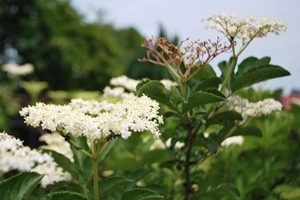By Mike Swan, Head of Education
 Flaming June, high summer, a time of long days, singing birds and sweet hedgerow scents. Fortunately, one of these scents can be bottled for the rest of the year: the elderflower. 30 years ago I had tasted a wonderful fizzy elderflower “champagne” made on ginger beer principles by my best man’s mother. Magnificent stuff, but it is a make and drink quickly project, that either goes off, or goes pop, if you try to store it. Being something of a home brewer, I tried higher alcohol versions too, but never really made anything palatable. Then I learned about elderflower cordial from Caroline Straker, and we have made it every year since.
Flaming June, high summer, a time of long days, singing birds and sweet hedgerow scents. Fortunately, one of these scents can be bottled for the rest of the year: the elderflower. 30 years ago I had tasted a wonderful fizzy elderflower “champagne” made on ginger beer principles by my best man’s mother. Magnificent stuff, but it is a make and drink quickly project, that either goes off, or goes pop, if you try to store it. Being something of a home brewer, I tried higher alcohol versions too, but never really made anything palatable. Then I learned about elderflower cordial from Caroline Straker, and we have made it every year since.
You need to lay in the following ingredients: lemons, granulated sugar, and citric acid. Then, on a warm dry day, go and gather elderflower heads, choosing those that are newly opened for first choice. Be careful to minimise the amount of main stalk attatched, as this smells (and therefore tastes) of tomcats rather than high summer! Then go straight home and address the following recipe: for every 30 flower heads pour over 2½ pints of boiling water; then add 3lb sugar, 2oz citric acid (50g if you need to be metric) and four lemons, thickly sliced. Mix all together, and do not worry if the flowers blacken. Leave for four days, but stir daily, and squish the lemons to get all the juice out.
After the four days strain through muslin or similar, and it is ready to use, if rather cloudy. If you are really fussy, you can filter through a jelly bag, but it does nothing to improve the taste. Personally, I squeeze it through the muslin to get as much as possible out, and therefore make it more cloudy.
If you bottle it and store in the fridge, the cordial will keep for several weeks, although it does ferment slowly. However, do not be put off by a little puff of gas when you open the bottle. It does not change the flavour, and if it mattered much my wife and I would be long dead. For longer-term storage we freeze in small plastic containers, and thaw out as needed, keeping just one bottle ‘on the go’ in the fridge.
To drink, simply dilute like squash, using fizzy water for preference, and add ice and a slice of lemon. You can use it still too, but the bubbles do lift both the flavour and that wonderful heady summer scent.
Elderflower cordial makes a wonderful flavouring for many other dishes, and can do great things for the juice in a summer fruit salad. It makes a particularly good partner to the tartness of early summer gooseberries (a fruit that is almost always picked under ripe for cooking). In my opinion the best use of this combination is in gooseberry and elderflower ice cream – made with a cream rather than a custard base, and to heck with the calories!
Photo credit: Rašo